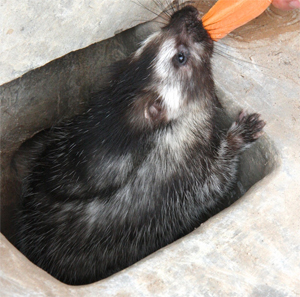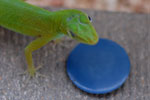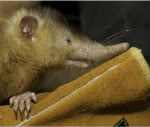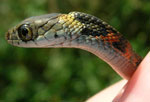The African crested rat, a rodent from East Africa, applies a toxin from tree bark to make itself poisonous, reports a new study published in Proceedings of The Royal Society B..
The discovery is the first known instance of a mammal acquiring its poison from a plant, according to the Wildlife Conservation Society, whose scientists were involved in the research. All other known poisonous mammals — including the duck-billed platypus, shrews and the solenodon — produce their toxins themselves.
“The African crested rat is a fascinating example of how a species can evolve a unique set of defenses in response to pressure from predators,” said Dr. Tim O’Brien, Senior Scientist of the Wildlife Conservation Society and a co-author on the study, in a statement. “The animal and its acquired toxicity are unique among placental mammals.”
 The African crested rat is the only mammal known to acquire its poison from a plant. The rodent masticates the poisonous bark of the Acokanthera tree and applies the slaver to its flank hairs, which absorb the poison like candle wicks. Photo credit: Susan Rouse. |
The African crested rat gets its toxin — called ouabain — from the Acokanthera tree, a tree used by East African hunters to poison the tips of their arrows.
Scientists have long suspected that the species is poisonous due to its behavior, which includes “exposing a black-and-white coloration on its flanks when threatened by predators” and “reports of dogs becoming ill or dying after encounters with rats,” according to WCS. But the study marks the first time scientists have been able to prove the African crested rat is toxic and that it derives its toxin in a novel manner for a mammal.
WCS explains how the scientists made their discovery:
-
The researchers confirmed the hypothesis by presenting a wild-caught rat with branches and roots of the Acokanthera tree. The rodent proceeded to gnaw and masticate the bark (avoiding the leaves and fruit) and apply the “slaver” on its flanks. Further, the research team employed electron microscopes to examine the unique structure of the flank hairs. In doing so, they found that the perforated cylindrical structure of the hairs facilitates the rapid absorption of the poisonous saliva. Interestingly, ouabain has also been used by doctors for centuries as a clinical treatment against congestive heart failure.
The rodent has characteristics that increase its odds of surviving attack, including “a thick reinforced skull, thick vertebrae, and unusually tough skin.”
The researchers say they still don’t know how the rodent uses the toxin without being adversely affected by it.
Jonathan Kingdon, et al. A poisonous surprise under the coat of the African Crested Rat. Proceedings of the Royal Society B. Available online Aug 2, 2011.
Related articles
(07/17/2011) A blackspot tuskfish (Choerodon schoenleinii) has been photographed picking up a clam in its mouth, swimming over to a rock, and then using the rock as an anvil by smashing the clam against it until it breaks open. In the journal Coral Reefs scientists argue this is the first conclusive evidence of a fish using tools. Once thought only the domain of humans, biologists have found that tool use is actually present all over the animal kingdom, from elephants to chimps, and crows to capuchins. Such tool use is often considered evidence of higher intelligence.
Brainy lizards rival birds in intelligence

(07/13/2011) Reptiles have long been thought to be dim-witted, but a new study in Biology Letters finds that the Puerto Rican anole, a type of lizard, can match birds in smarts. Using cognitive tests that have been previously used on birds, researchers with Duke University found that the lizards were capable of solving a problem they’ve never encountered before, remembering the solution in future trials, and even changing techniques when presented with new challenges. In fact, the tiny anoles solved the test with fewer tries than birds. Given reptiles’ reputation of being slow-on-the uptake the head author, Manuel Leal, said the findings are ‘completely unexpected’.
Updating the top 100 weirdest and most imperiled mammals

(01/24/2011) A lot can change in three years. In January 2007, the Zoological Society of London (ZSL) jumpstarted a program unique in the conservation world: EDGE, which stands for Evolutionarily Distinct and Globally Endangered, selects the species it works with not based on popularity or fund-raising potential but on how endangered and evolutionary unique (in laymen’s terms: weird) they are. When EDGE first arrived in 2007, it made news with its announcement of the world’s top 100 most unique and endangered mammals. While this list included a number of well-known species—such as the blue whale and the Asian elephant—it also introduced the public to many little-recognized mammals that share our planet, such as the adorable long-eared jerboa, the ancient poisonous solenodon, and the ET-like aye-aye. However, after three years the EDGE program found that their top 100 mammals list already need updating.
How rainforest shamans treat disease

(11/10/2009) Ethnobotanists, people who study the relationship between plants and people, have long documented the extensive use of medicinal plants by indigenous shamans in places around the world, including the Amazon. But few have reported on the actual process by which traditional healers diagnose and treat disease. A new paper, published in the Journal of Ethnobiology and Ethnomedicine, moves beyond the cataloging of plant use to examine the diseases and conditions treated in two indigenous villages deep in the rainforests of Suriname. The research, which based on data on more than 20,000 patient visits to traditional clinics over a four-year period, finds that shamans in the Trio tribe have a complex understanding of disease concepts, one that is comparable to Western medical science. Trio medicine men recognize at least 75 distinct disease conditions—ranging from common ailments like fever [këike] to specific and rare medical conditions like Bell’s palsy [ehpijanejan] and distinguish between old (endemic) and new (introduced since contact with the outside world) illnesses. In an interview with mongabay.com, Lead author Christopher Herndon, currently a reproductive medicine physician at the University of California, San Francisco, says the findings are a testament to the under-appreciated healing prowess of indigenous shaman.
Rediscovery of the solenodon, a rare venomous mammal, in Haiti

(01/09/2009) In the journal Oryx researchers from EDGE, a program of the Zoological Society of London (ZSL), have announced the rediscovery of a small population of Hispaniolan solenodons in Haiti. At the same time scientists in the Dominican Republic have taken the first ever footage of this endangered mammal.
Snake uses trick to avoid poisoning from toxic frogs
(10/16/2007) An Australian snake employs a special feeding behvaior to avoid poisoning by toxic frogs, reports The American Naturalist.
Snake becomes poisonous by eating toxic frogs

(01/29/2007) A new study shows that the Asian snake Rhabdophis tigrinus becomes poisonous by sequestering toxins from its prey which consists of venomous toads. While sequestering defensive toxins from prey is unusual among terrestrial vertebrates it is not unknown. Research published last year by Valerie C. Clark of Cornell University showed that poison dart frogs (Dendrobates species) and their Madagascar counterparts, the Mantella frogs, sequester toxic skin chemicals, called alkaloids, from the ants they eat. These alkaloids protect the frogs from predation. Similarly, some garter snakes are known to store tetrodotoxin from ingested newts while birds in New Guinea appear to sequester poisons from insects.
How did rainforest shamans gain their boundless knowledge on medicinal plants?
(05/14/2005) For thousands of years, indigenous people have extensively used rainforest plants for their health needs — the peoples of Southeast Asian forests used 6,500 species, while Northwest Amazonian forest dwellers used 1300 species for medicinal purposes. Perhaps more staggering than their boundless knowledge of medicinal plants, is how shamans and medicinemen could have acquired such knowledge. There are over 100,000 plant species in tropical rainforests around the globe, how did indigenous peoples know what plants to use and combine especially when so many are either poisonous or have no effect when ingested. Many treatments combine a wide variety of completely unrelated innocuous plant ingredients to produce a dramatic effect.
Shamans and Robots: Bridging the Past and Future of Ethnobotany and Bioprospecting
(04/25/2005) A look at trends in ethnobotany and bioprospecting in seeking new ways to address human health conditions.